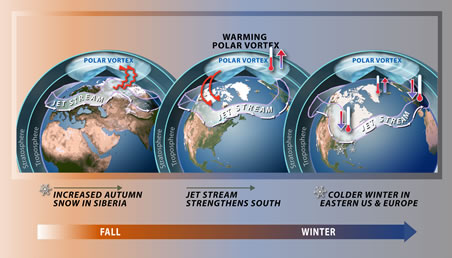
The illustration above nicely illustrates this relationship, showing how the snow cover enhances the waves that set up the cold patterns like we've seen this year and last year. It is amazing to watch these powerful atmospheric waves propagate across our planet and grow over Siberia. We recently saw such a wave develop in December that helped establish the recent cold, and a new one is expected to move across Eurasia in the coming week. You can watch these waves (way up toward the top of the troposphere) via an excellent National Weather Service animation.
So is this all we ever need to know about seasonal forecasting? Is this relationship the magic bullet?
Unfortunately, two important caveats limit the technique:
First, the prediction of Siberian snow itself is a challenge. I had the honor of sitting on a seasonal forecast panel with Dr. Cohen in late September 2009. For this WeatherBug Seasonal Conference, Dr. Cohen referenced below normal snow in Siberia to support his very warm 09-10 winter outlook for North America. My Commodity Weather Group team was forecasting a cold and snowy winter due to signs that the North Atlantic pattern (NAO) and the emerging El Niño pattern would be supportive. Within weeks of that conference, it began snowing in Siberia. A lot. And by late October, his very warm winter outlook had switched 180 degrees to a cold forecast. The Siberian snow correlation requires knowing what Siberian snow is going to do.
Second, while I have no doubt that enhanced snow pack in Eurasia is amplifying these waves that warm the Polar stratosphere and creating our mammoth blocking patterns (translation: cold U.S., Europe, and Asia winter), something else is initiating these waves. The reason I believe this is that in October 1998, we had well above normal Eurasian snowfall, but we DID NOT have a cold Eastern U.S. winter. Instead, tropical forcing from a powerful La Niña dominated our warm winter weather. The Siberian snow was there, but the waves were not.
The last two winters have featured relentless waves, triggering cold blocking patterns never before seen in modern times. Last winter's Arctic Oscillation (AO) was the lowest in the modern record (back to 1950). The North Atlantic Oscillation (NAO) has averaged negative for an unprecedented 15 straight months now. While the Siberian snow is enhancing the waves and blocking, the waves do not start there, and Siberian snow has been heavier than recent years.
So why the record-setting levels? One might argue that the Siberian snow connection is the "elephant's tail"- an important clue, but not the whole story.
So what is the whole story? Believe it or not, I would like to reference a paper co-authored by Michael Mann and Gavin Schmidt in 2001. In that paper, the authors discuss a correlation between low solar activity during the Maunder Minimum, also known as the Little Ice Age, and strong Arctic and North Atlantic Oscillation behavior that drives colder winters to North America, Europe, and Asia. Page 3 of that short paper shows a map of the colder mid-latitude continents associated with low solar activity and high levels of blocking. The last few years have seen the quietest solar activity since the early 1800s and recent research suggests the sun may even go quieter yet. What was the climate like in the early 1800s?
Think London. Charles Dickens. And then look at the news stories from the last two brutal winters in Europe. To quote another blogger, "we live in interesting times".
I'll post more on this developing issue in the future.



Reader Comments
to our Newsletter